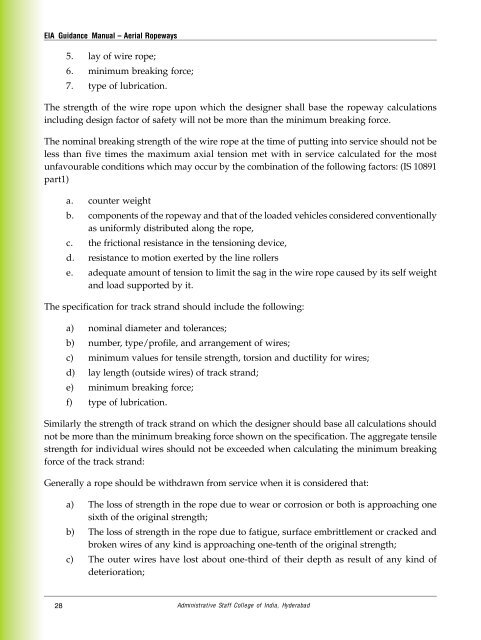Aerial Ropeways - Environmental Clearance
Aerial Ropeways - Environmental Clearance
Aerial Ropeways - Environmental Clearance
You also want an ePaper? Increase the reach of your titles
YUMPU automatically turns print PDFs into web optimized ePapers that Google loves.
EIA Guidance Manual – <strong>Aerial</strong> <strong>Ropeways</strong>5. lay of wire rope;6. minimum breaking force;7. type of lubrication.The strength of the wire rope upon which the designer shall base the ropeway calculationsincluding design factor of safety will not be more than the minimum breaking force.The nominal breaking strength of the wire rope at the time of putting into service should not beless than five times the maximum axial tension met with in service calculated for the mostunfavourable conditions which may occur by the combination of the following factors: (IS 10891part1)a. counter weightb. components of the ropeway and that of the loaded vehicles considered conventionallyas uniformly distributed along the rope,c. the frictional resistance in the tensioning device,d. resistance to motion exerted by the line rollerse. adequate amount of tension to limit the sag in the wire rope caused by its self weightand load supported by it.The specification for track strand should include the following:a) nominal diameter and tolerances;b) number, type/profile, and arrangement of wires;c) minimum values for tensile strength, torsion and ductility for wires;d) lay length (outside wires) of track strand;e) minimum breaking force;f) type of lubrication.Similarly the strength of track strand on which the designer should base all calculations shouldnot be more than the minimum breaking force shown on the specification. The aggregate tensilestrength for individual wires should not be exceeded when calculating the minimum breakingforce of the track strand:Generally a rope should be withdrawn from service when it is considered that:a) The loss of strength in the rope due to wear or corrosion or both is approaching onesixth of the original strength;b) The loss of strength in the rope due to fatigue, surface embrittlement or cracked andbroken wires of any kind is approaching one-tenth of the original strength;c) The outer wires have lost about one-third of their depth as result of any kind ofdeterioration;28Administrative Staff College of India, Hyderabad
















